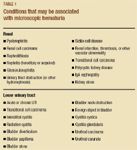4 steps to evaluation of asymptomatic microscopic hematuria
Routine urinalysis shows RBCs, but your patient has no symptoms. Is treatment necessary? This four-point plan will help you more quickly get to that answer.
Microscopic hematuria is common and can be caused by a wide variety of medical conditions. The strict definition of hematuria is three or more red blood cells (RBCs) per high-power field in at least two of three properly collected urinalysis specimens.1 But there is no threshold of microscopic hematuria under which significant disease can be ruled out.2 In this article, I lay out a four-point plan for evaluating women with asymptomatic microscopic hematuria, based on the latest data in the medical literature.
Epidemiology of the problem
Various cross-sectional studies have placed the prevalence of microscopic hematuria at between 2.5% and 13% of the adult population.3 Once you've discovered microscopic hematuria, ruling out malignancy is usually the highest priority, and bladder cancer is the malignancy you are most likely to find. Every year, about 15,000 new cases of bladder cancer are diagnosed in US women, making it the most common urinary tract malignancy (and essentially as common as cervical cancer).4 Alishahi and colleagues estimate that 2.9% of adults who have asymptomatic hematuria are ultimately diagnosed with a malignancy.5

Detecting hematuria

If you can identify and rule out one of these factors as a possible cause of asymptomatic microscopic hematuria, it's appropriate to simply repeat the dipstick urinalysis. However, if you can't identify an obvious, reversible factor, even one positive dipstick urinalysis should prompt further investigation-usually by a urogynecologist or urologist. [Some authors suggest ordering a confirmatory formal urinalysis and microscopy after an initial dipstick finding of hematuria, but the usefulness of that has not been established.] In a study of 1,000 urine samples, Gleeson and colleagues reported a 5% incidence of urinary tract malignancy in patients with dipstick-positive, microscopy-negative hematuria.9 In the minds of clinicians, microscopy findings may "trump" dipstick findings, but there is no evidence to support that assumption.
Self-diagnosing vaginismus found accurate vs health care provider diagnosis
October 15th 2024In a recent study presented at the 25th Annual Fall Scientific Meeting of SMSNA, similar diagnosing success was reported between self-diagnosis and diagnosis from a health care provider for vaginismus.
Read More
Study: Pelvic floor dilator reduces pelvic floor muscle injury during vaginal delivery
August 6th 2024A new pilot study published in the International Urogynecology Journal found that Materna Medical’s Prep Device, a pelvic floor dilator, reduced full levator ani muscle avulsion during vaginal delivery in first-time mothers.
Read More
